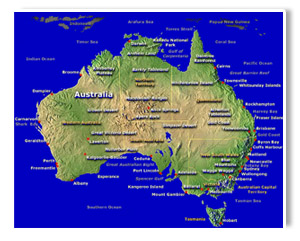Lord Howe Island: an Australian island with South Sea flair
 Lord Howe Island, Australia - Friendly locals, no stress, lush green mountains and a deep blue sea. These are the main characteristics of Australia' Lord Howe Island. With its South Sea feeling you might think Lord Howe Island is on its way to being overrun by tourists. But tourism is tightly controlled on the island: Its 350 residents may only accept a maximum of 400 visitors at a time.
Lord Howe Island, Australia - Friendly locals, no stress, lush green mountains and a deep blue sea. These are the main characteristics of Australia' Lord Howe Island. With its South Sea feeling you might think Lord Howe Island is on its way to being overrun by tourists. But tourism is tightly controlled on the island: Its 350 residents may only accept a maximum of 400 visitors at a time.
House doors and bicycles are never locked on Lord Howe Island. Its sole policeman is mainly concerned with making sure the requirement for cyclists to wear a helmet is observed. Islanders like the slow pace of life and in a recent survey 70 per cent said they did not want a mobile phone network.
If you intend spending your holiday on Lord Howe Island you will be far off the beaten track - and the weather is likely to be ideal as well. It is never too hot and almost never too cold. "When the temperature rises to 27 degrees we all just lie down and do nothing," says local nature guide Ian Hutton.
Most things we associate with Down Under are missing here: there are few eucalyptus trees, no koala bears, no kangaroos and no Aboriginal art as Australia's indigenous people never lived on the island.
In 1788 British seafarers sighted the island's high mountains and named the new discovery after the then navy chief Lord Howe. Like many islands in the region, Lord Howe Island is the remains of a volcano that eroded away long ago. "After seven million years about two per cent of the volcano has been left over," explains Hutton. In another 200,000 to 300,000 years the rest of the island will sink beneath the Pacific Ocean's waves.
The highest peak on Lord Howe is Mount Gower at 875 metres. Climbers must take a licensed guide with them if they plan on reaching the top. If you take a tour of the mountain you will quickly discover why that rule exists. The tour gets going at 7.40 am. On this day mountain guide Jack Shick has 16 guests in his party. There are 8-year-olds in the group as well as some senior citizens.
The tour is routine for Jack as it will be the 1,187th time he has climbed the mountain. The entire journey takes about nine hours which is a lot less than the first time the mountain was climbed in 1869 when trekkers took two days to reach the top. However, it is also a lot longer than the triathletes take - they do the climb in one hour and 41 minutes. Mount Gower has been hosting triathlons since the 1990s.
The path tourists take heads first around the western flank of the island's second mountain, the 777-metre-high Mount Lidgbird. In single file climbers then walk past 100-metre-high cliffs before the path divides into two. One path leads into the island's forest interior while the other makes its way up the 75-degree-angle mountain face.
There is a rope to help climbers up the mountain and it is generally at this point that you wish you weighed 10 kilograms less. But with some ambition, courage and the prospect of a wonderful view of the island and the open Pacific, most people keep going.
After a few more steps you are at the top which is covered in a thick cloud forest. Moss, ferns, palm trees and climbing plants make up the forest which is home to the Lord Howe Wood Hen. This flightless bird lives nowhere else on the planet.
After returning from Mount Gower your muscles will hurt and there will be scratches on your legs from the undergrowth. But if you are not ready for the rigours of Mount Gower there are other less strenuous tours. In the north of the island there is a pleasant circular route that begins on Ned's Beach which was voted Australia's cleanest in 2004 and 2005.
Many of the tourists who come here walk into the waist-deep sea with bread in their hands to feed the fish. The path continues to the 208-metre-high Malabar Hill where there is one of the best panoramas of Mount Gower and Mount Lidgbird and the many small rocky outcrops that lie to the north-east. The cliffs in that part of the island are very steep.
Almost all of the tourists who come here regret having to leave and promise to come back again some day. But it is almost impossible to buy a house on Lord Howe Island. Only the descendants of the three families that originally colonised Lord Howe in the 19th century or people who have lived for at least 10 years on the island may buy land here. On average only one building permit is issued a year, according to Ian Hutton.
There are no plans to build new hotels on Lord Howe so it appears the island will keep its good looks and remain a place off the beaten track. (dpa)